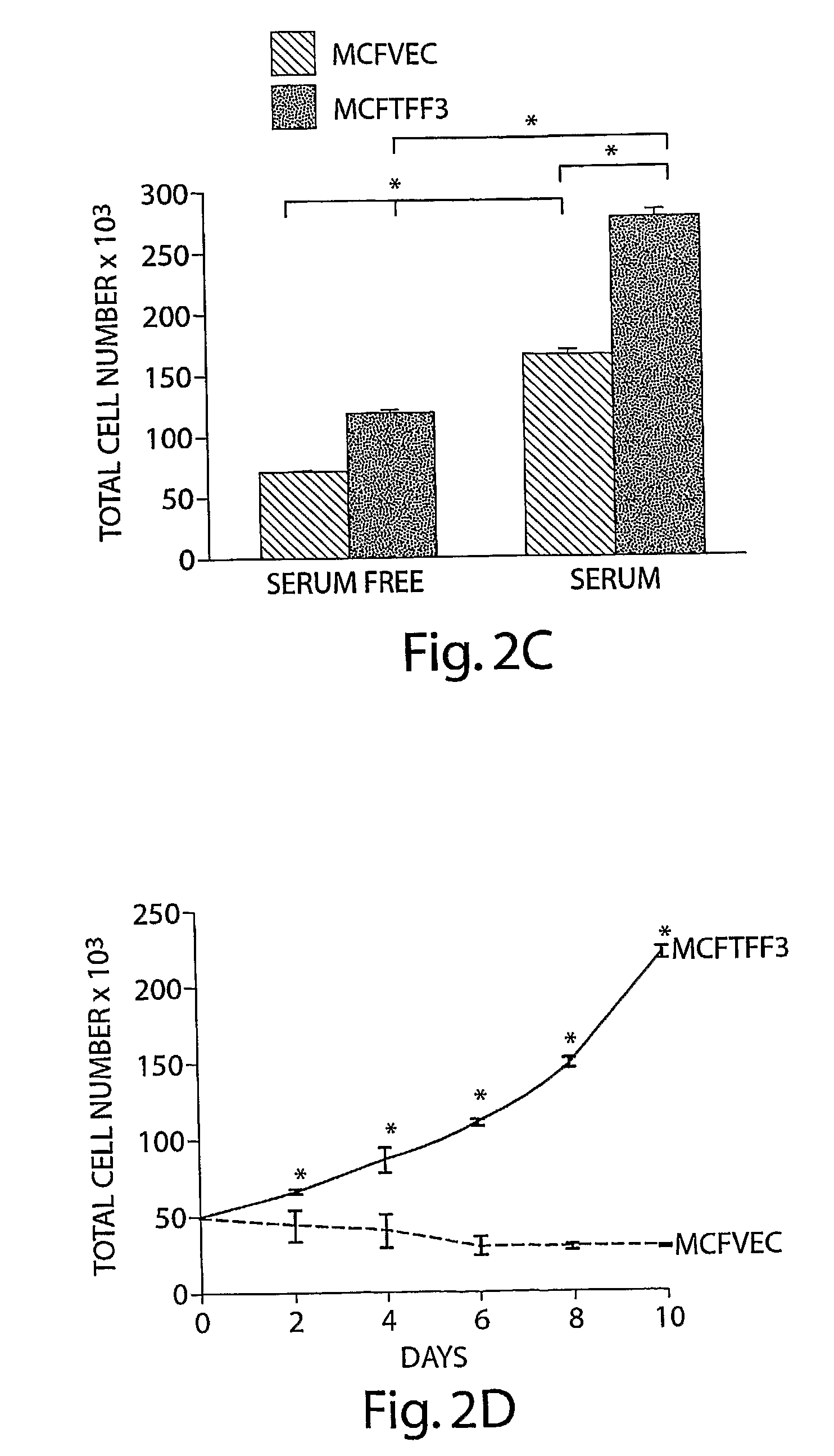Trefoil Factors and Methods of Treating Proliferation Disorders Using Same
a proliferation disorder and trefoil factor technology, applied in the field of trefoil factors and methods of treating proliferation disorders using same, can solve the problems of reducing tumor load, affecting the cell death, etc., and achieve the effects of inhibiting the binding of an endogenous tff, inhibiting the function of tff, and inhibiting the dimerization of
- Summary
- Abstract
- Description
- Claims
- Application Information
AI Technical Summary
Benefits of technology
Problems solved by technology
Method used
Image
Examples
example 1
TFF3 Increases Oncogenicity and Stimulates Oncogenic Transformation; Inhibition of TFF Decreases Oncogenicity
[0072]TFF3 increases mammary carcinoma cell mitogenesis and survival and hence cell number. The inventors cloned the complete human TFF3 cDNA and sequence verified the clones. The inventors subsequently generated a human mammary carcinoma (MCF-7) cell line with stable expression of TFF3 and compared the behavior of these cells to vector transfected control cells. Expression of TFF3 was confirmed by RT-PCR for TFF3 mRNA (FIG. 1.). Expression of TFF3 increased mitogenesis of human mammary carcinoma cells (as indicated by 5′-bromo-2′-deoxyuridine labeling of nuclei) (FIG. 2A) and increased cell survival in serum deprived conditions (FIG. 2B). Consequently TFF3 produced an increase in total mammary carcinoma cell number in both serum deprived and serum containing conditions (FIGS. 2C, D).
[0073]TFF3 increases anchorage-independent growth in human mammary carcinoma cells. One chara...
example 2
Estradiol and Tamoxifen Treatment Induces Increase in Transcriptional Levels of TFF in Human Breast Adenocarcinoma Cells
[0077]MCF7 cells have been shown to produce endogenous levels of TFF3, and TFF3 has been shown to be over-expressed in estrogen receptor positive breast cancers. It was of interest to determine if the expression of TFF3 is related to estrogen receptor status. MCF7 cells were cultured in phenol red free RPMI 1640 containing 10% dextran coated charcoal stripped fetal bovine serum in a 6 well plate for 24 hours. Then the cells were changed to treatment media containing 10 nM E2 or 1 μM TAM and cultured for 24 hours in the same. Untreated cells cultured in serum free media acted as controls. FIG. 7A shows very high increased transcript levels of TFF3 in cells treated with estradiol (E2) and significantly but not as high transcript levels of TFF3 when treated with tamoxifen (TAM). β-Actin was used for checking RNA integrity and also acted as a loading control. FIG. 7B s...
example 3
TFF3 produces resistance to Tamoxifen induced cell death
[0078]To determine if TFF3 would alter the responsiveness of human mammary carcinoma cells to agents used therapeutically to treat mammary carcinoma, the effect of forced expression of TFF3 was tested on soft agar colony formation in the presence of tamoxifen. MCF-7 cells with forced expression of TFF3 more than quadrupled soft agar colony formation in the presence of tamoxifen than vector transfected controls (FIG. 8). TFF3 therefore decreases the sensitivity of cells to the effects of antiestrogenic compounds used to treat mammary carcinoma.
[0079]MCF7 cells produce endogenous levels of TFF1. MCF7 cells were cultured in phenol red free RPMI 1640 containing 10% dextran coated charcoal stripped fetal bovine serum in a 6 well plate for 24 hours. Then the cells were changed to treatment media containing 10 nM E2 or 1 μM TAM and cultured for 24 hours in the same. Untreated cells cultured in serum free media acted as controls. FIG. ...
PUM
| Property | Measurement | Unit |
|---|---|---|
| Electrical resistance | aaaaa | aaaaa |
| Pharmaceutically acceptable | aaaaa | aaaaa |
| Sensitivity | aaaaa | aaaaa |
Abstract
Description
Claims
Application Information
 Login to View More
Login to View More - R&D
- Intellectual Property
- Life Sciences
- Materials
- Tech Scout
- Unparalleled Data Quality
- Higher Quality Content
- 60% Fewer Hallucinations
Browse by: Latest US Patents, China's latest patents, Technical Efficacy Thesaurus, Application Domain, Technology Topic, Popular Technical Reports.
© 2025 PatSnap. All rights reserved.Legal|Privacy policy|Modern Slavery Act Transparency Statement|Sitemap|About US| Contact US: help@patsnap.com



